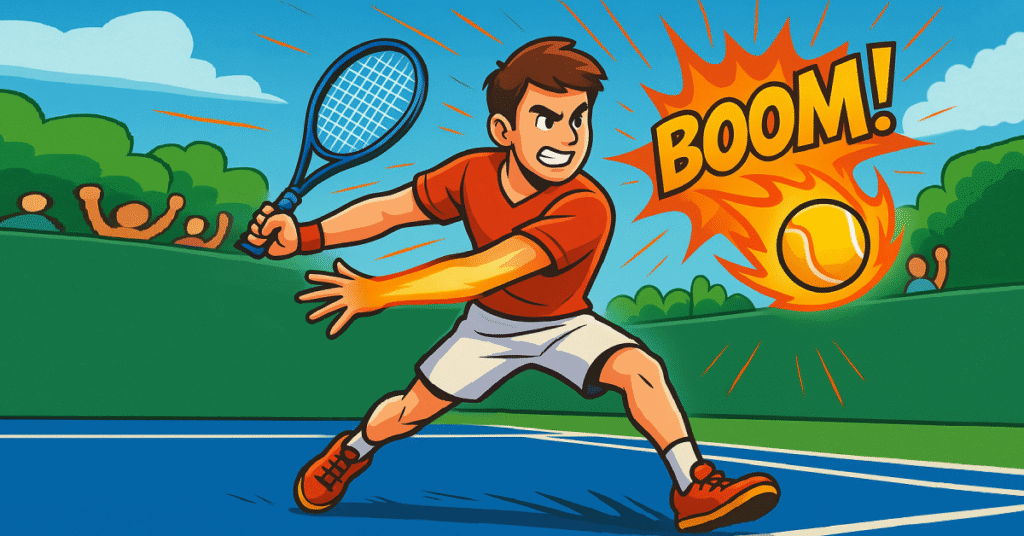
✨ Intro
Forehand technique can feel like black magic — especially when you see ATP pros like Alcaraz or Federer unleash that explosive “pop” with zero effort.
For years, I struggled with the same issue. Despite grinding for hours and hitting thousands of balls, I couldn’t generate true, effortless power.
Everything changed when I stopped muscling the ball and started using my body the right way.
I discovered a set of biomechanical forehand technique adjustments that helped me add over 35 MPH to my forehand, almost effortlessly.
In this article, I’ll break down what I changed — so you can do it too.
🎾 Want to Build Your Forehand From Scratch?
Learn the foundations of the modern forehand — including grip, stance, and timing. If you’re just starting over, this is where to begin.
How I Added 35 MPH to My Forehand (and How You Can Too)
By relaxing my arm, using my whole body instead of just my arm, and adding a controlled wrist whip, I transformed my forehand from functional to explosive. These three changes alone added 35 MPH of effortless power — and turned a weakness into a true weapon.
🎯 What Makes a Powerful Forehand?
Many players think power comes purely from arm strength or swinging harder.
In reality, true forehand power comes from using your entire body efficiently, sequencing your movements, and keeping everything relaxed.
That’s the foundation of great forehand technique.
Modern forehand technique emphasizes:
- Proper shoulder and hip rotation
- Using the kinetic chain (legs → hips → shoulders → arm → racket)
- Relaxed arm and wrist
- Timing and contact point optimization
🔥 Forehand Technique Breakdown: How I Added 35 MPH (Step-by-Step)
✅ Step 1: Prepare With Shoulder Twist, Not Just Your Arm
Most amateur players start their preparation by pulling the racket back with their arm.
Instead, focus on twisting your shoulders to prepare.
Think of coiling your upper body like a spring — this stores energy that you’ll release into the ball.
This rotational prep is a key element of modern forehand technique.
✅ Step 2: Keep Your Arm Completely Relaxed
Treat your arm like a rope.
When it’s tense, you lose whip and speed.
When it’s relaxed, it acts like a natural lever that multiplies your body’s rotational energy.
This “dead arm” feeling may feel strange at first, but it is key to unlocking effortless forehand technique power.
✅ Step 3: Set the Correct Wrist and Racket Position
At the end of your preparation:
- The tip of your racket should face the net.
- The opposite side of your palm should face you.
This pre-stretches your forearm muscles and naturally sets up a lag position, creating whip at contact.
✅ Step 4: Use the Ground-Up Kinetic Chain
Start your swing from the ground up:
- Push with your legs.
- Rotate your hips.
- Let your shoulders follow.
- Finally, your arm and wrist will naturally unfold.
When this sequence happens correctly, you don’t have to “force” power.
Your whole body contributes to racket head speed, which is the hallmark of biomechanically sound forehand technique.
Not Sure If Your Backhand Has Similar Issues?
Check out this full backhand breakdown — it covers the same principles of body flow and control, adapted for both one- and two-handers.
✅ Step 5: Let the Wrist Whip Naturally
Don’t try to force the wrist to “snap” on its own — that’s a common mistake. You’re not cracking a whip manually.
Instead, the wrist whip should be a natural result of everything you’ve done before: your stance, your body rotation, your relaxed arm, and your timing.
If your body sequencing is correct — meaning your legs, hips, torso, and arm all rotate in sync — the wrist will release effortlessly.
It’s like a chain reaction: energy flows upward through your body, and the wrist is the final link that unleashes the power.
The momentum travels up your kinetic chain and reaches the wrist last, unleashing a whip-like motion with zero tension.
This relaxed release adds both topspin and racquet head speed, giving your forehand that explosive, yet controlled, finish.
In my case, it added over 15 MPH almost overnight.
Pro tip: If you try to snap your wrist manually, you’ll disrupt the flow and probably lose control.
Focus on staying loose, and let the energy do the work.
💡 Why This Forehand Technique Works — The Biomechanics Behind It
This approach follows the same principles top pros use.
Players like Alcaraz, Sinner, and Tsitsipas all use a more compact preparation, combined with a full, relaxed extension at contact.
By focusing on body rotation and relaxation instead of raw muscle effort, you create elastic energy, resulting in effortless power and more topspin.
⚠️ Common Forehand Technique Mistakes to Avoid
A lot of players lose power not because of lack of strength, but because of incorrect sequencing and tension. Here are the biggest mistakes I see:
- Preparing only with your arm: Pulling the racket back with your arm instead of coiling your shoulders stops your body from contributing to the shot.
- Keeping your arm too stiff: A rigid arm blocks the whip effect and often causes timing issues.
- Hitting with your arm only: Trying to “arm” the ball leads to forced swings and inconsistent contact.
Correcting these is essential if you want to tap into true biomechanical forehand technique power.
🟢 Drills to Practice Forehand Power and Relaxation
Building effortless forehand power starts with letting go of tension and training your body to move as one fluid system.
These drills aren’t just warmups — they reprogram your forehand technique at the source.
Building effortless forehand power starts with letting go of tension and training your body to move as one fluid system.
These drills aren’t just warmups — they reprogram your forehand technique at the source.
Mastering these can genuinely add 20–35 mph to your forehand over time, without muscling the ball.
🎾 Shadow Swings
Without a ball, practice slow, relaxed swings focusing on shoulder coil and hip rotation. Feel your body unwind naturally.
The goal here is to groove the motion and feel how your arm becomes a loose whip — not a hammer.
This helps lock in smooth, modern forehand technique mechanics.
🟢 Slow-Motion Swing Drills
Hit balls at 50% speed while exaggerating relaxation and full-body sequencing.
Focus on the kinetic chain — feet to hips to shoulders to arm.
You’re not trying to hit hard here; you’re training your forehand technique to become clean, controlled, and efficient.
⚡ Wall Rebound Drill

Stand close to a wall and hit short, controlled forehands. Keep your swing snappy but relaxed.
You’ll feel any tension in your wrist or elbow immediately.
This drill sharpens timing, rhythm, and the wrist release in your forehand technique — especially useful for players with overly rigid swings.
🔥 Dead Arm Toss Drill
With a partner or ball machine, consciously relax your arm as much as possible during your swing.
Let the ball come to you and whip through with your body, not your bicep.
The more relaxed your arm, the easier it becomes to generate natural forehand power using proper forehand technique.
🎾 Equipment Considerations for More Forehand Power
While technique is the biggest factor, your equipment can make a difference too.
A racket with a slightly more flexible frame or lower string tension can help add depth and power.
If you use extremely high tension or a control-oriented racket, you might need to swing harder to get the same result.
👉 For a detailed breakdown, check out my Best Tennis Rackets Guide.
➤ Need a Racket That Matches Your Swing?
Explore the best tennis rackets by style and level — including my top picks for power, spin, and control.
🧠 Mindset and Mental Cues

One of the biggest breakthroughs for me was realizing that power doesn’t come from trying to hit the ball as hard as possible.
Instead, focus on:
- Relaxation first
- Feeling the rhythm of the swing
- Prioritizing clean contact point over brute force
Think of your swing as a smooth dance rather than an aggressive punch. When you shift your mindset to flow and timing, power often comes naturally.
🧠 My Forehand Journey: From Lost Weapon to Ultimate Comeback
When I was younger, I lost my forehand, and it was honestly a horrible experience.
It took me nearly a year and a half to rebuild it — and even then, it was just functional.
It got the job done, but it was never the weapon I hoped it could be.
After a 13-year break from tennis, I stepped back onto the court — determined to build a modern forehand from scratch.
What changed everything? I watched Federer.
That’s when I realized two things:
- I had never truly used my body — I had been muscling every forehand with just my arm.
- I had never fully grasped the power of a loose, extended hitting arm.
Once I started applying those two principles, everything changed.
My forehand became smooth, free-flowing, and shockingly consistent.
And the bonus? It added 15 mph to my shot. For the first time in my life, my forehand wasn’t just “good enough” — it started to feel like a real weapon.
But I still craved more.
That’s when I introduced the forehand whip — a loose-wristed release that lets the racquet snap through contact like a whip.
The difference was jaw-dropping.
If you stay relaxed and follow the steps I outlined above, you can transform your forehand too.
Power, consistency, confidence — it’s all there, waiting.
🎁 Final Thoughts
Adding power to your forehand isn’t about hitting harder — it’s about moving smarter.
The moment you stop muscling the ball and start letting your body sequence naturally, you unlock a level of tennis most players never reach.
✅ Focus on body rhythm
✅ Keep your arm loose
✅ Whip through contact effortlessly
It’s not about forcing power — it’s about releasing it.
FAQ
How do I add more power to my tennis forehand?
Power starts with technique. A relaxed grip, proper stance, and kinetic chain timing (legs → core → arm) generate effortless speed. Avoid muscling the ball — use your body efficiently instead.
What’s the biggest mistake players make when trying to hit harder?
Tensing up. Many players grip too tightly or swing too hard with the arm alone. This kills both spin and speed. Modern forehands rely on loose, explosive mechanics and rotational force.
Can I really add 35 MPH to my forehand?
While 35 MPH is a stretch for some, it’s absolutely possible if your current technique has major inefficiencies. With modern training, many recreational players unlock 20–35 MPH gains over time.
How has modern forehand technique changed from older styles?
Today’s forehands use semi-western grips, open stances, and extreme rotation to create topspin and pace. This contrasts with older, flatter strokes — modern technique allows for more power with less effort.
Do I need a specific racket or string setup for more power?
Not necessarily, but a more powerful racket and lower-tension strings can help. Technique always comes first — gear is secondary but can complement your style once your form is dialed in.
If you want to go deeper, check out my full breakdown: [Modern Forehand Technique Guide] — it’ll walk you step by step through every element of today’s most effective forehands.
